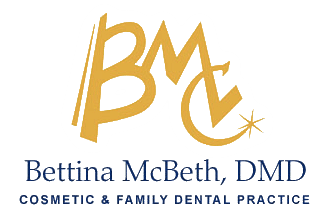Crowns cover the visible area of a severely decayed tooth. They can make a tooth look more attractive, replace a filling, and offer support for bridges.
What Are Crowns?
Crowns, or caps, can cover the visible area of a tooth once it has been extensively decayed or damaged. After removing the damaged part of the tooth, Dr. McBeth will fit a crown securely over the top of it, covering anything above the gum line. Most crowns are made with a porcelain, metal or gold base, and then coated with a thin layer of ceramic for a natural and beautiful finish. Beyond the cosmetic aspect, crowns may also be used to replace defective or aging fillings, teeth that may be too damaged for repair, or used as support for bridges.
What Does the Procedure Involve?
Normally, patients can expect the procedure for inserting the crown to take two (or more) visits. The initial visit will include a general cleaning and x-ray, and if a crown is decided as the best option the dentist will then proceed to remove decay from the tooth and take an impression. The tooth’s foundation will remain intact (it is needed to serve as an anchor) and a temporary crown will be placed on the tooth. When the permanent crown is fabricated, the patient will return to the office and Dr. McBeth will install the fixture. During the follow-up visit, the crown will be properly aligned, polished, and shaped to match the natural teeth and original bite pattern.
Crowns are prescribed for damaged, decayed, or broken teeth.
The tooth is prepared by eliminating surface structure.
After fabrication the crown is cemented to the prepared tooth.
Crowns restore natural beauty and health of teeth.





